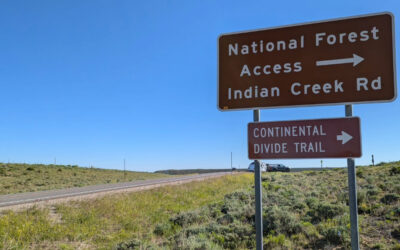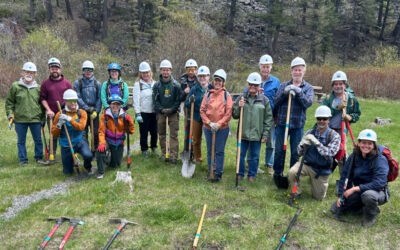GOLDEN, CO (February 11, 2021) — Today, the Interior Department reinforced the original intent of the Land and Water Conservation Fund (LWCF) by rescinding the previous administration’s policy which threatened the success of this critical conservation program. Secretarial Order 3396 repeals a previous order signed late last year that chipped away at the efficacy of LWCF by creating new, unnecessary restrictions for land and water acquisitions. This new order from DOI brings the Continental Divide Trail Coalition (CDTC) one step closer in its mission to complete the trail and protect the Continental Divide experience.
Since the Continental Divide Trail (CDT) was established by Congress in 1978, LWCF has played an integral part in completing the construction of the trail by allocating funds for the acquisition of private lands from willing sellers. Of the 3,100 miles of the trail stretching from Mexico to Canada, 95 percent of the CDT is located on public land; however, approximately 180 miles are not on public land and are still in need of protection. Despite decades of progress, the CDT remains incomplete due to gaps in public lands where the trail is forced to follow dangerous highways and roads. Just outside of Steamboat Springs at Muddy Pass in Colorado, for example, Continental Divide Trail travelers are forced to walk along the sides of Highway 14 and 40 for almost 15 miles due to lack of access to public lands. Funds from LWCF could mean the opportunity to provide a safer, more enjoyable experience for all those who recreate along the Continental Divide.
“Secretarial Order 3396 is a relief for the many communities who see the completion of the trail as a lifeline for their local economies, which depend on public lands and the outdoor recreation industry to attract business to their community,” says Dan Carter, Trail and Land Conservation Manager at CDTC. “LWCF also supports land owners willing to sell their lands to support the completion of trails like the CDT by ensuring there is federal funding to complete the purchase in a timely fashion. This is an indispensable resource for the completion of the trail — one that CDTC and our partners have come to depend on in our mission to increase accessibility and connectivity along the Continental Divide. LWCF is not only the best tool, it is often the only tool to help with the completion of the CDT.”
Along with removing the restrictions on LWCF funds, the new secretarial order also strives to generate greater recreation opportunities for underserved communities by re-implementing the Outdoor Recreation Legacy Partnership (ORLP) program. The ORLP program is a competitive grant that aims to provide funding to address the recreational opportunity gap, mainly in urban areas. More recreational opportunities for underserved youth is a great step toward achieving greater equity in outdoor spaces.
LWCF was established in 1964 as part of a bi-partisan effort to save natural resources and public lands all over the country. Last year, the Great American Outdoors Act (GAOA) was passed by Congress with bipartisan support, which permanently funded LWCF at $900 million per year. These funds are generated primarily by revenue from the oil and gas industry drilling offshore in federal waters. Funds from LWCF have already been used to preserve iconic places all along the Divide such as Browns Canyon National Monument in Colorado, Petroglyph National Monument in New Mexico, and Grant Kohrs Ranch in Montana.
Greater access to public lands and more recreational opportunities through LWCF means safer, more equitable opportunities for CDNST travelers and outdoor enthusiasts to enjoy the wonders along the Continental Divide. Secretarial Order 3396 will help CDTC continue its efforts to protect and complete the trail for the enjoyment of all people and for future generations.
About the Continental Divide Trail
The CDT is one of the world’s premiere long-distance trails, stretching 3,100 miles from Mexico to Canada along the Continental Divide. Designated by Congress in 1978, the CDT is the highest, most challenging and most remote of the 11 National Scenic Trails. It provides recreational opportunities ranging from hiking to horseback riding to hunting for thousands of visitors each year. While 95% of the CDT is located on public land, approximately 150 miles are still in need of protection.
About the Continental Divide Trail Coalition
The CDTC was founded in 2012 by volunteers and recreationists hoping to provide a unified voice for the Trail. Working hand-in-hand with the U.S. Forest Service and other federal land management agencies, the CDTC is a non-profit partner supporting stewardship of the CDT. The mission of the CDTC is to complete, promote and protect the Continental Divide National Scenic Trail, a world-class national resource. For more information, please visit continentaldividetrail.org.
#####



